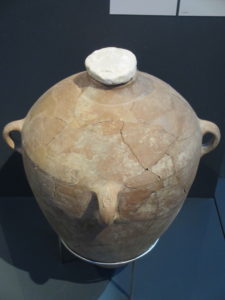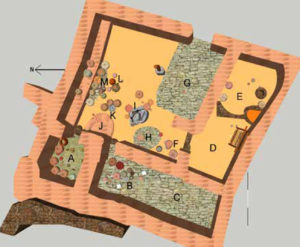New insights into biblical food storage
Jennifer Drummond May 25, 2022 0 Comments 613 views


A restored lmlk storage jar from the Kingdom of Judah. Impressed with the phrase lmlk—meaning “belonging to the king”—such royally administered storage jars were used to distribute military rations, collect taxes, or support the kingdom in times of war.
Credit: Chamberi, CC BY-SA 3.0 , via Wikimedia Commons.
Sustainability is something we hear about a lot these days. New items are developed every day to help reduce waste in our daily lives. One area that has long been sustainable is food storage. Earl Tupper created his first storage container in 1942; a few years later, Tupperware became a household name. Mr. Tupper’s idea, however, wasn’t entirely new.
Across the millennia, people and cultures from all over the world, including in ancient Israel and Judah, have been using reusable containers—mostly pottery—to store and keep food. As Tim Frank explains in “Storage and Staples in Biblical Israel” in the Spring 2022 issue of Biblical Archaeology Review, archaeologists can study Israelite pottery and other material evidence to learn how the average person managed issues of food preparation and storage.


At the site of Tel Halif in southern Israel (possibly biblical Rimmon: Joshua 15:32; 19:7), Frank carefully studied ancient Israelite pottery related to food processing and storage. The site was suddenly and violently destroyed by the Assyrians in 701 B.C.E. In the face of the city’s imminent demise, many of the inhabitants fled, abandoning their houses and, for archaeologists, leaving behind a snapshot of daily household use and organization. This included food containers, which were left in their “normal” positions, allowing Frank to effectively study an ancient pantry. According to Frank, “Storage jars were found beside other artifacts, such as an oven and a grinding installation, but also put together in little groups. The location of storage jars and other items was not random; there was purpose in how the household was organized.”


This digital reconstruction shows a typical Iron Age dwelling at Tel Halif; the letters indicate different areas of domestic activity, like food preparation, cooking, and storage.
Credit: Courtesy of Tim Frank.
Through digital modeling, Frank and the Halif team were able to show how and where food was stored in ancient Judah, as revealed by recent excavations. The image above shows a typical Iron Age dwelling at Tel Halif; the letters indicate different areas of domestic activity. Food preparation—grinding grain, cooking, chopping, etc.—was conducted in Areas H, I, J, and K. Domestic work, such as weaving, would have been done in Areas D and E. Areas B and C served as a living space. Area M would have been used for agricultural production, while the cobbled floor in Area G likely served as a stable.
In addition to archaeology, ethnography—the study of living peoples and their cultures—also plays a major role in the study of ancient household organization. By comparing the lives and practices of living or historically documented peoples with the archaeological remains of ancient societies who lived in comparable settings, archaeologists can gain insight into how households were organized or how certain objects were used. For example, how pre-industrial farmers organized and stored their food can give valuable insights into how a household in ancient Judah may have functioned or how Israelite pottery was used. Of course, ethnographic comparisons can only explain so much, as societies and their historical contexts are constantly changing. But ethnographic studies, when combined with archaeology and textual studies, can help form a picture of ancient daily life.
To learn more about food storage in ancient Israel and Judah, read “Storage and Staples in Biblical Israel” by Tim Frank, published in the Spring 2022 issue of Biblical Archaeology Review.
———-Subscribers: Read the full piece, “Storage and Staples in Biblical Israel” by Tim Frank, published in the Spring 2022 issue of Biblical Archaeology Review.
Not a BAS Library or All-Access Member yet? Join today.
Read more in Bible History Daily:
All-Access members, read more in the BAS Library:
What’s For Dinner? The Answer Is In the Pot
Get more biblical Archaeology: Become a Member
The world of the Bible is knowable. We can learn about the society where the ancient Israelites, and later Jesus and the Apostles, lived through the modern discoveries that provide us clues.
Biblical Archaeology Review is the guide on that fascinating journey. Here is your ticket to join us as we discover more and more about the biblical world and its people.
Each issue of Biblical Archaeology Review features lavishly illustrated and easy-to-understand articles such as:
• Fascinating finds from the Hebrew Bible and New Testament periods
• The latest scholarship by the world’s greatest archaeologists and distinguished scholars
• Stunning color photographs, informative maps, and diagrams
• BAR’s unique departments
• Reviews of the latest books on biblical archaeology
The BAS Digital Library includes:
• 45+ years of Biblical Archaeology Review
• 20+ years of Bible Review online, providing critical interpretations of biblical texts
• 8 years of Archaeology Odyssey online, exploring the ancient roots of the Western world in a scholarly and entertaining way,
• The New Encyclopedia of Archaeological Excavations in the Holy Land
• Video lectures from world-renowned experts.
• Access to 50+ curated Special Collections,
• Four highly acclaimed books, published in conjunction with the Smithsonian Institution: Aspects of Monotheism, Feminist Approaches to the Bible, The Rise of Ancient Israel and The Search for Jesus.
The All-Access membership pass is the way to get to know the Bible through biblical archaeology.

